Unit2 There is a park near my home Lesson12 教案
文档属性
| 名称 | Unit2 There is a park near my home Lesson12 教案 | 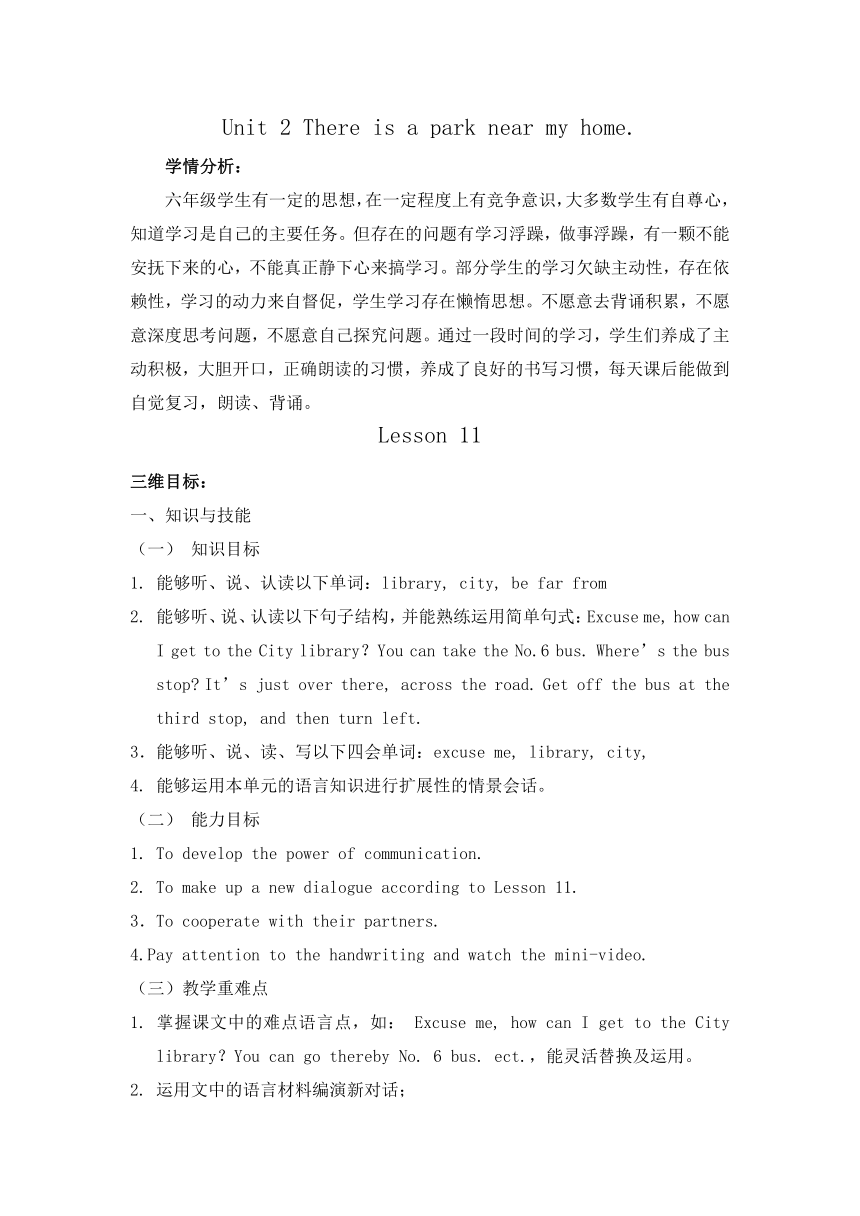 | |
| 格式 | doc | ||
| 文件大小 | 100.5KB | ||
| 资源类型 | 教案 | ||
| 版本资源 | 人教精通版(三年级起点) | ||
| 科目 | 英语 | ||
| 更新时间 | 2022-05-26 16:45:25 | ||
图片预览

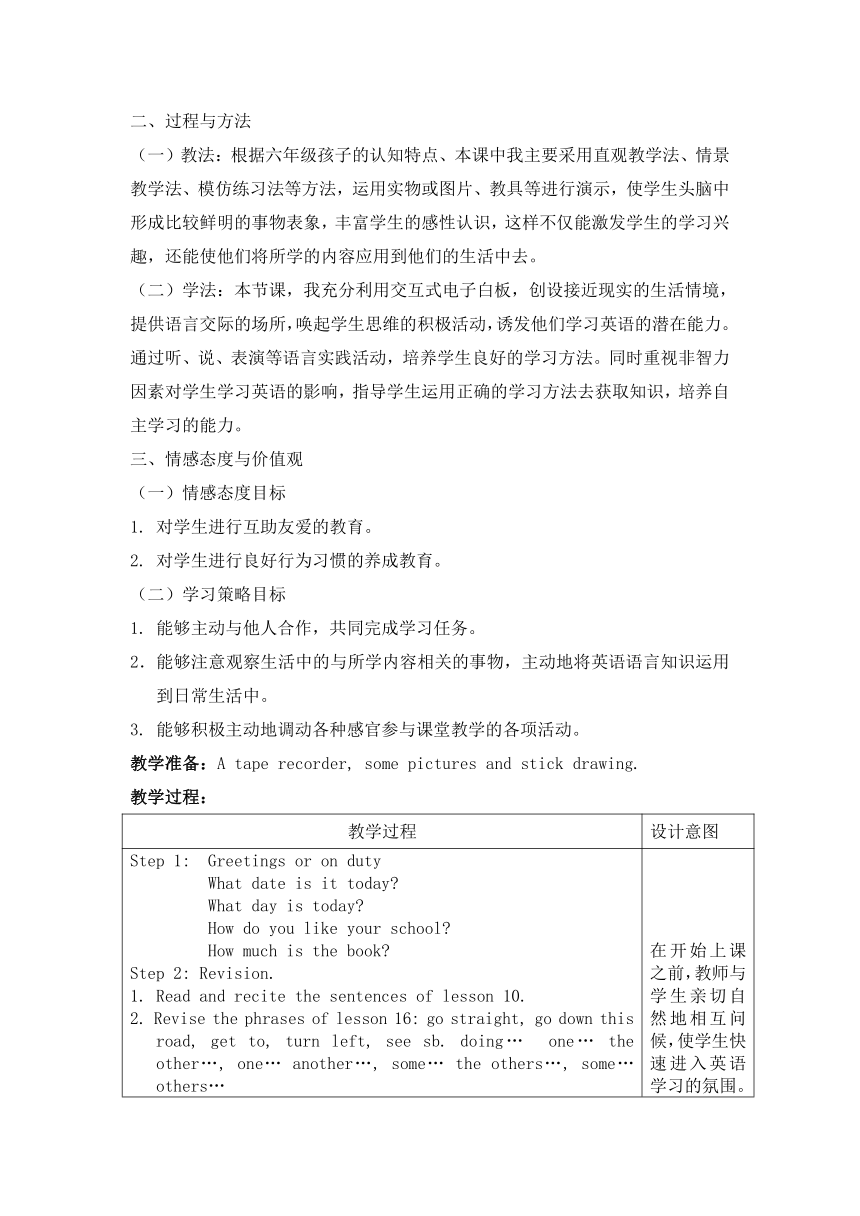
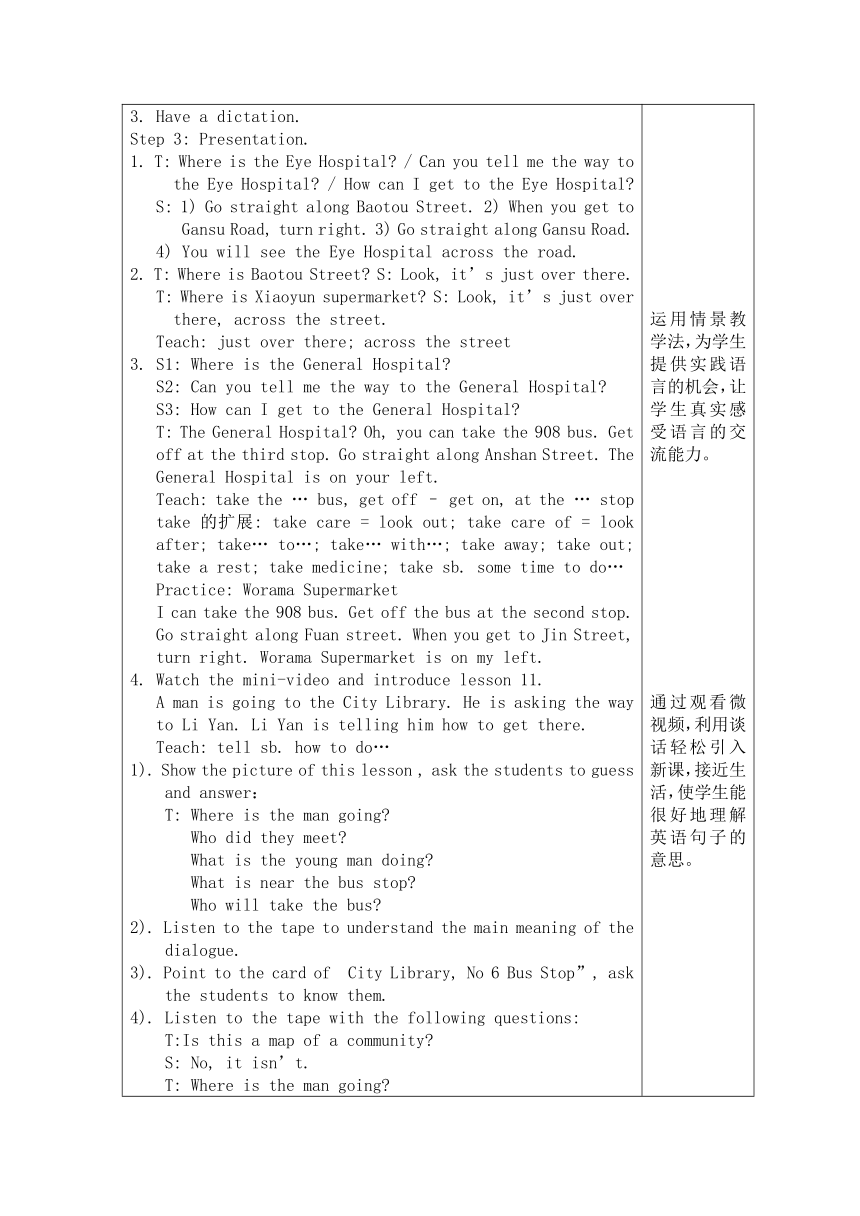
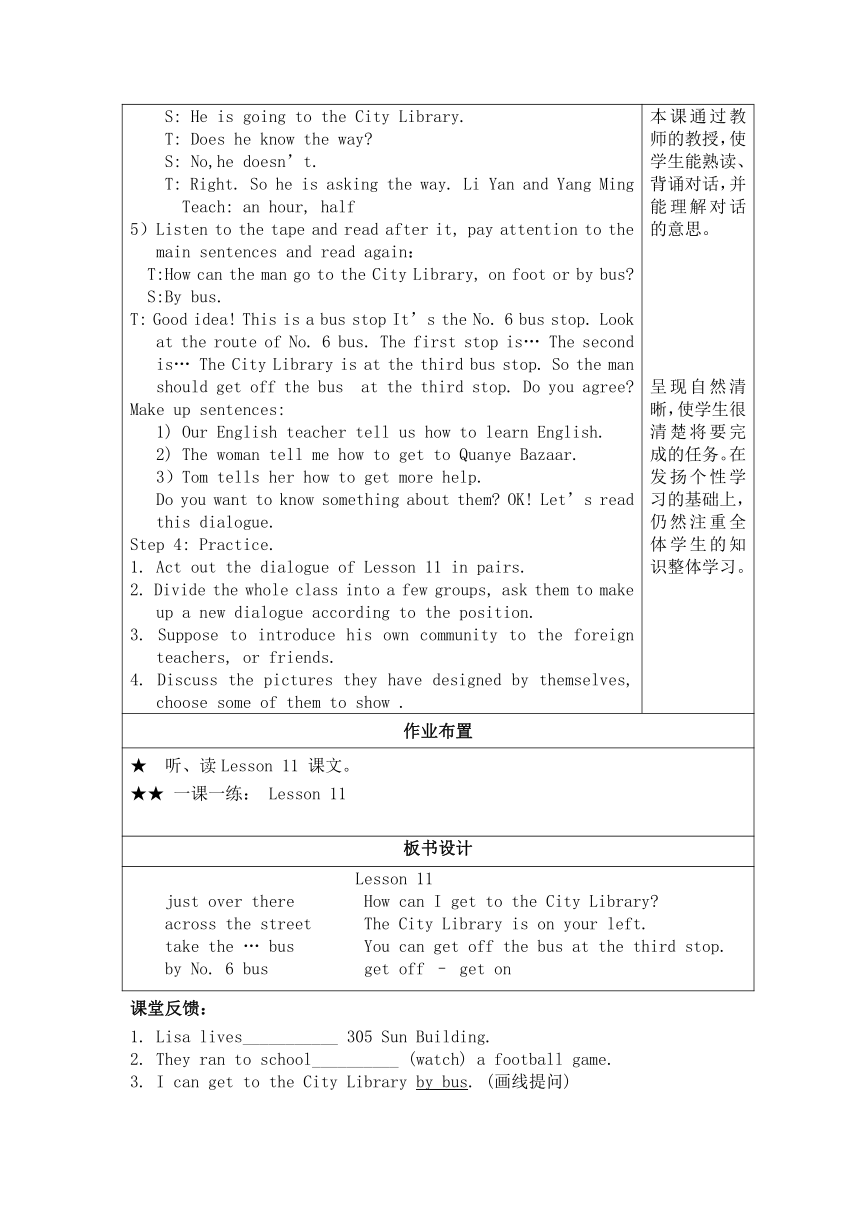
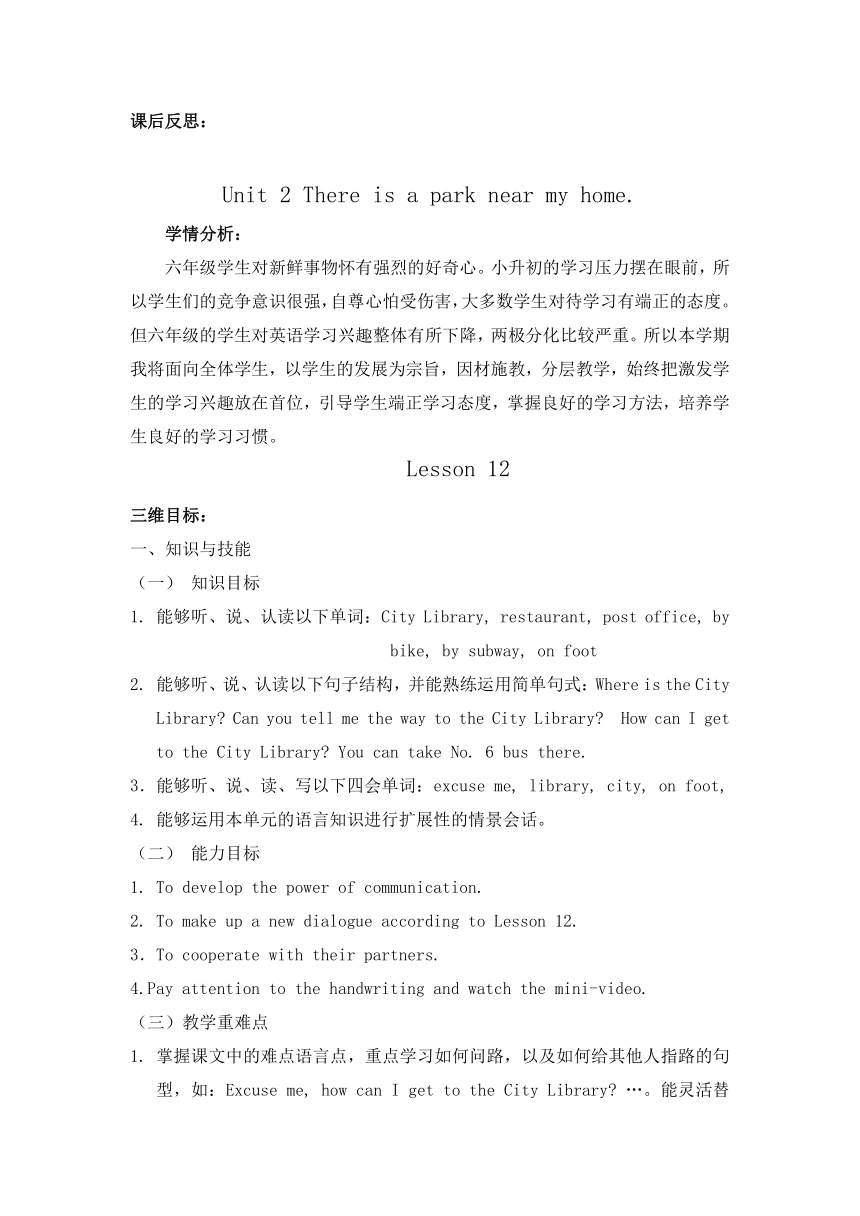
文档简介
Unit 2 There is a park near my home.
学情分析:
六年级学生有一定的思想,在一定程度上有竞争意识,大多数学生有自尊心,知道学习是自己的主要任务。但存在的问题有学习浮躁,做事浮躁,有一颗不能安抚下来的心,不能真正静下心来搞学习。部分学生的学习欠缺主动性,存在依赖性,学习的动力来自督促,学生学习存在懒惰思想。不愿意去背诵积累,不愿意深度思考问题,不愿意自己探究问题。通过一段时间的学习,学生们养成了主动积极,大胆开口,正确朗读的习惯,养成了良好的书写习惯,每天课后能做到自觉复习,朗读、背诵。
Lesson 11
三维目标:
一、知识与技能
(一) 知识目标
1. 能够听、说、认读以下单词:library, city, be far from
2. 能够听、说、认读以下句子结构,并能熟练运用简单句式:Excuse me, how can I get to the City library?You can take the No.6 bus. Where’s the bus stop It’s just over there, across the road. Get off the bus at the third stop, and then turn left.
3.能够听、说、读、写以下四会单词:excuse me, library, city,
4. 能够运用本单元的语言知识进行扩展性的情景会话。
(二) 能力目标
1. To develop the power of communication.
2. To make up a new dialogue according to Lesson 11.
3.To cooperate with their partners.
4.Pay attention to the handwriting and watch the mini-video.
(三)教学重难点
1. 掌握课文中的难点语言点,如: Excuse me, how can I get to the City library?You can go thereby No. 6 bus. ect.,能灵活替换及运用。
2. 运用文中的语言材料编演新对话;
二、过程与方法
(一)教法:根据六年级孩子的认知特点、本课中我主要采用直观教学法、情景教学法、模仿练习法等方法,运用实物或图片、教具等进行演示,使学生头脑中形成比较鲜明的事物表象,丰富学生的感性认识,这样不仅能激发学生的学习兴趣 ( http: / / home.51.com / _sid=homek" \t "_blank ),还能使他们将所学的内容应用到他们的生活中去。
(二)学法:本节课,我充分利用交互式电子白板,创设接近现实的生活情境,提供语言交际的场所,唤起学生思维的积极活动,诱发他们学习英语的潜在能力。通过听、说、表演等语言实践活动,培养学生良好的学习方法。同时重视非智力因素对学生学习英语的影响,指导学生运用正确的学习方法去获取知识,培养自主学习的能力。
三、情感态度与价值观
(一)情感态度目标
1. 对学生进行互助友爱的教育。
2. 对学生进行良好行为习惯的养成教育。
(2) 学习策略目标
1. 能够主动与他人合作,共同完成学习任务。
2.能够注意观察生活中的与所学内容相关的事物,主动地将英语语言知识运用到日常生活中。
3. 能够积极主动地调动各种感官参与课堂教学的各项活动。
教学准备:A tape recorder, some pictures and stick drawing.
教学过程:
教学过程 设计意图
Step 1: Greetings or on dutyWhat date is it today What day is today How do you like your school How much is the book Step 2: Revision.1. Read and recite the sentences of lesson 10. 2. Revise the phrases of lesson 16: go straight, go down this road, get to, turn left, see sb. doing… one… the other…, one… another…, some… the others…, some… others…3. Have a dictation.Step 3: Presentation.1. T: Where is the Eye Hospital / Can you tell me the way to the Eye Hospital / How can I get to the Eye Hospital S: 1) Go straight along Baotou Street. 2) When you get to Gansu Road, turn right. 3) Go straight along Gansu Road. 4) You will see the Eye Hospital across the road.2. T: Where is Baotou Street S: Look, it’s just over there. T: Where is Xiaoyun supermarket S: Look, it’s just over there, across the street. Teach: just over there; across the street3. S1: Where is the General Hospital S2: Can you tell me the way to the General Hospital S3: How can I get to the General Hospital T: The General Hospital Oh, you can take the 908 bus. Get off at the third stop. Go straight along Anshan Street. The General Hospital is on your left.Teach: take the … bus, get off – get on, at the … stop take 的扩展: take care = look out; take care of = look after; take… to…; take… with…; take away; take out; take a rest; take medicine; take sb. some time to do…Practice: Worama SupermarketI can take the 908 bus. Get off the bus at the second stop. Go straight along Fuan street. When you get to Jin Street, turn right. Worama Supermarket is on my left.4. Watch the mini-video and introduce lesson 11.A man is going to the City Library. He is asking the way to Li Yan. Li Yan is telling him how to get there.Teach: tell sb. how to do… 1). Show the picture of this lesson , ask the students to guess and answer:T: Where is the man going Who did they meet What is the young man doing What is near the bus stop Who will take the bus 2). Listen to the tape to understand the main meaning of the dialogue.3). Point to the card of City Library, No 6 Bus Stop”, ask the students to know them.4). Listen to the tape with the following questions:T:Is this a map of a community S: No, it isn’t.T: Where is the man going S: He is going to the City Library.T: Does he know the way S: No,he doesn’t.T: Right. So he is asking the way. Li Yan and Yang Ming Teach: an hour, half 5)Listen to the tape and read after it, pay attention to the main sentences and read again: T:How can the man go to the City Library, on foot or by bus S:By bus.T: Good idea! This is a bus stop It’s the No. 6 bus stop. Look at the route of No. 6 bus. The first stop is… The second is… The City Library is at the third bus stop. So the man should get off the bus at the third stop. Do you agree Make up sentences:1) Our English teacher tell us how to learn English.2) The woman tell me how to get to Quanye Bazaar.3)Tom tells her how to get more help.Do you want to know something about them OK! Let’s read this dialogue.Step 4: Practice.1. Act out the dialogue of Lesson 11 in pairs.2. Divide the whole class into a few groups, ask them to make up a new dialogue according to the position.3. Suppose to introduce his own community to the foreign teachers, or friends.4. Discuss the pictures they have designed by themselves, choose some of them to show . 在开始上课之前,教师与学生亲切自然地相互问候,使学生快速进入英语学习的氛围。运用情景教学法,为学生提供实践语言的机会,让学生真实感受语言的交流能力。通过观看微视频,利用谈话轻松引入新课,接近生活,使学生能很好地理解英语句子的意思。本课通过教师的教授,使学生能熟读、背诵对话,并能理解对话的意思。呈现自然清晰,使学生很清楚将要完成的任务。在发扬个性学习的基础上,仍然注重全体学生的知识整体学习。
作业布置
★ 听、读Lesson 11 课文。 ★★ 一课一练: Lesson 11
板书设计
Lesson 11just over there How can I get to the City Library across the street The City Library is on your left.take the … bus You can get off the bus at the third stop.by No. 6 bus get off – get on
课堂反馈:
1. Lisa lives___________ 305 Sun Building.
2. They ran to school__________ (watch) a football game.
3. I can get to the City Library by bus. (画线提问)
课后反思:
Unit 2 There is a park near my home.
学情分析:
六年级学生对新鲜事物怀有强烈的好奇心。小升初的学习压力摆在眼前,所以学生们的竞争意识很强,自尊心怕受伤害,大多数学生对待学习有端正的态度。但六年级的学生对英语学习兴趣整体有所下降,两极分化比较严重。所以本学期我将面向全体学生,以学生的发展为宗旨,因材施教,分层教学,始终把激发学生的学习兴趣放在首位,引导学生端正学习态度,掌握良好的学习方法,培养学生良好的学习习惯。
Lesson 12
三维目标:
一、知识与技能
(一) 知识目标
1. 能够听、说、认读以下单词:City Library, restaurant, post office, by bike, by subway, on foot
2. 能够听、说、认读以下句子结构,并能熟练运用简单句式:Where is the City Library Can you tell me the way to the City Library How can I get to the City Library You can take No. 6 bus there.
3.能够听、说、读、写以下四会单词:excuse me, library, city, on foot,
4. 能够运用本单元的语言知识进行扩展性的情景会话。
(二) 能力目标
1. To develop the power of communication.
2. To make up a new dialogue according to Lesson 12.
3.To cooperate with their partners.
4.Pay attention to the handwriting and watch the mini-video.
(三)教学重难点
1. 掌握课文中的难点语言点,重点学习如何问路,以及如何给其他人指路的句型,如:Excuse me, how can I get to the City Library …。能灵活替换及运用。
2. 运用文中的语言材料编演新对话;
二、过程与方法
(一)教法:根据六年级孩子的认知特点、本课中我主要采用交际教学法、活动 ( http: / / home.51.com / _sid=homek" \t "_blank )教学法、多媒体辅助教学法等方法,利用图片来创设情景,培养学生的创新精神。及时对学生的学习进行评价和激励,并充分利用交互电子白板的各种功能有效地辅助教学。
(二)学法:在学习英语的过程中,合作学习是一种良好的行之有效的方法。合作学习要求学生向别人提问,表达自己的观点,这样不但可提高学生的学习能力,而且更能促进他们对学习的兴趣。他们的英语口语也日渐流畅,最终提高了学生的自信达到了综合运用语言的目的。
三、情感态度与价值观
(一)情感态度目标
1. 对学生进行互助友爱的教育。
2. 对学生进行良好行为习惯的养成教育。
(2) 学习策略目标
1. 能够主动与他人合作,共同完成学习任务。
2.能够注意观察生活中的与所学内容相关的事物,主动地将英语语言知识运用到日常生活中。
3. 能够积极主动地调动各种感官参与课堂教学的各项活动。
教学准备:A tape recorder, some pictures and stick drawing.
教学过程:
教学过程 设计意图
Step 1: Greetings or on duty:What do you like What colour do you like What kind of animals do you like What do you want What do you want to do What would you like What subject do you like best How many months are there in a year How many months are there in a season How many seasons are there in a year What are they Which season is the first season of the year When does it begin Which season is the second season of the year Which season do you like best Step 2: Revision.1. Read and recite the dialogue of lesson 12.2. Have a dictation.3. Invite a few groups to act out the dialogue of Lesson 17 to the class.4. Choose a few pictures made by the students, ask them to describe it in English and give the assessments.5. Offer some interests and shopping centers ,ask the students to talk about the way to get there in English.Step 3. Presentation.1. Use one of the students’ pictures and ask:T: Where is the … How can I get to… T: Where is the City Library How can I get to the City Library S: You can take No. 6 bus there.2. Show the picture of shopping center and say:T: Look! Here’s a shopping centre.I want to go to the shopping centreDo you want to go How can you get to the shopping centre 3. Use the same method to teach the words and phrases.1). T: How can I get to the shopping centre S: You can take the No. … bus there.Teach: shopping centre / food stall2). S: How can I get to the City Library T: You can go there on foot.Teach: on foot / by bus (on a bus; take a bus) / by subway4. Listen to “Just practice”,ask the students to read after it and choose some of the students to read it. 5. Help the students to play a touching game, see who is the fastest.6. Invite two of the students to write some words and sentences from “Just write” on the blackboard, then ask the students to read together.7. Let’s read and chant. 1). Let the students read and translate the sentences. 2). Let them listen to the tape, then chant it.3). Listen to the chant, underline : ere,and pay more attention to it.4). Act out the chant in groups, make up a new chant with“How can I get to… You can take….”Step 4: Watch the mini video and practice.1. Do the exercises:(1).How can I get to the Shopping centre 同义句1: Can you tell me the way to the shopping centre 同义句2: Where is the shopping centre (2).You can go to the shopping centre on foot. 画线提问: How can you go to the shopping centre 同义句1: Can you tell me the way to the shopping centre 同义句2: Where is the shopping centre (3).You can go there by bus.同义句1: You can go there ob a bus.同义句2: You can take a bus there.画线提问: How can you go there 2. Read the words, phrases and sentences of lesson 12.3. Ask the students to choose and match the pictures by themselves to practice the main and difficult points of this lesson.4. Let the students play. Ask and answer questions in pairs, two students a groups.5. Choose a few groups to act out the dialogue in the class. 6. Choose one of the places on the map,find out the different ways to get there. Free talk通过课前的对话,热身活动,既活跃了课堂气氛,调动了学生的学习兴趣。设计复习这一环节可以帮助学生回忆上节课所学的语言项目,强化记忆,并对所学的知识加以理解。小组合作学习体现了对学生的尊重为学生开设了相互交流的机会。我们要特别注意小组活动的实效性,使学生在合作中竞争、学习。通过观看句型转换的微视频,逐步引导学生掌握该题型的方法。变生活为课堂,让学生在创设的真实生活情景中,通过合作、表演把语言真正运用到实际生活中去,发展学生的语言能力。
作业布置
★ 一课一练:Lesson 12 ★★ 双课闯关:Lesson 11 & Lesson 12
板书设计
Lesson 12restaurant subway post office City Librarygo there on foot go there by bus go there by subwayWhere is the City Library How can I get to the City Library
课堂反馈:
1. At last, he turns right for__________ third time.
2. A few__________ (travel) came to school.
3. Which is the way to the school (同义句)
课后反思:
Unit 2 There is a park near my home.
学情分析:
六年级的学生活泼好动,纯真可爱。大部分学生喜欢上英语课,上课时能够专心听讲,能够积极主动的发言,思想比较单纯,善于提问。 但是有一部分学生不是很喜欢上英语课,学习兴趣不是很高,个别学生甚至有厌恶感,同时,有些学生还是为学习而学习,谈不上兴趣问题;个别同学在课堂上纪律不是很好,还存在顽劣和懒惰倾向。通过努力,学生们已经从被动学习变成了主动学习,学生们英语交流能力有所提高,思维也普遍活跃起来,自信心也增强了,学生们的英语水平与课堂学习的积极性显著提高。
Revision
三维目标:
一、知识与技能
(一) 知识目标
1. 能够听、说、认读以下单词和短语:Where is… / Turn right / left. Go straight / down… Walk behind… You will see/ find…
2. 能够听、说、认读以下句子结构,并能熟练运用简单句式:There be…
Asking the way.
3.能够听、说、读、写以下四会单词:straight, behind
4. 能够运用本单元的语言知识进行扩展性的情景会话。
(二) 能力目标
1. To develop the ability of creation.
2. To act out the fun story.
3.To cooperate with their partners.
4.Pay attention to the handwriting and watch the mini-video.
(三)教学重难点
1. 掌握课文中的难点语言点,重点学习如何问路,以及如何给其他人指路的句型,如:Excuse me, how can I get to the post office …。能灵活替换及运用。
2. 运用文中的语言材料编演新对话;
二、过程与方法
(一)教法:根据六年级孩子的认知特点、本课中我主要采用讲授法、情景教学法、表演法、演示法等方法,使学生获得丰富的感性材料,加深对事物的印象,利用实物、图片、表情动作等创设大量的视觉情景,对儿童反复进行大量的可理解性语言输入,进行反复多遍的听说活动 ( http: / / home.51.com / _sid=homek" \t "_blank )。丰富学生的感性认识,增强演示效果,而尽可能快的使学生的认识上升到理性阶段,形成概念,掌握事物的本质。
(二)学法:本节课,我从学生的生活经验和已有的知识出发,创设生动有趣的教学情境,通过听、说、表演等语言实践活动,使学生们掌握基本的知识和技能,培养学生良好的学习方法。同时指导学生运用正确的学习方法去获取知识,培养自主学习的能力。
三、情感态度与价值观
(一)情感态度目标
1. 培养学生积极、热情待人的感情。
2. 对学生进行良好行为习惯的养成教育。
(2) 学习策略目标
1. 能够主动与他人合作,共同完成学习任务。
2.能够注意观察生活中的与所学内容相关的事物,主动地将英语语言知识运用到日常生活中。
3. 能够积极主动地调动各种感官参与课堂教学的各项活动。
教学准备:A tape recorder, some pictures and stick drawing.
教学过程:
教学过程 设计意图
Step 1: Greetings.Step 2: Revision.1. Read lesson 7, 9 and 11.2. Revise the phrases of this unit. 3. Make up new dialogues according to the dialogues of this unit.Step 3: Presentation.1. T: Micky and the bear are talking. Do you know what are they talking about Read this story. And then ask again.S: They are talking about how to get to the post office.2. T: What’s in bear’s hand S: A map. T: He points to the map and asks Micky. Teach: point to…3. T: How does Micky tell him S: Go straight ahead.Teach: ahead (ad.)4. T: What else does Micky say S: He says: You should go straight until you see a yellow house. Teach: until5. T: What does the bear do S: The bear begins to look for the post office.Teach: begin to do sth. 6. T: How many times does the bear turn right S: Three times. T: How do you know (Read this paragraph.)Teach: at last, for(表时间、次数的持续) a third time7. T: The bear meet Micky again. What does Micky ask S: Why have you come back (现在完成时) ( Read this sentence.)What’s wrong (What’s the matter ) (What’s wrong/the matter about … )Step 4: Practice. 1. Acting out the fun story.2. Do the exercises:(1).How can I get to the Shopping centre 同义句1: Can you tell me the way to the shopping centre 同义句2: Where is the shopping centre (2).You can go to the shopping centre on foot. 画线提问: How can you go to the shopping centre 同义句1: Can you tell me the way to the shopping centre 同义句2: Where is the shopping centre (3).You can go there by bus.同义句1: You can go there ob a bus.同义句2: You can take a bus there.画线提问: How can you go there Step 5: Fun FactsT: Central Park in New York is one of the most famous parks in the world. It is a very big park. Listen carefully and answer the questions.What is the most famous park in the world What will visitors from other countries do there What do Chinese people usually do in a park James lives near Central Park in New York. Here are some activities that James does in Central Park. Write about some activities that you do in your park.What does James do in Central Park What do you do in your park 1.He takes his dog for a walk.1.2.He listens to music in the park.2.He jogs around the lake.3. 衔接前面所学内容,既是检查旧知,又是所学知识的拓展和延伸。通过图片直观地展现几个不同场景,给学生们提供可谈论的话题,可以围绕不同的场景活动并结合自己的生活实际交流。通过讨论、问答等多种形式练习巩固,使学生更扎实地掌握新知识。
作业布置
★ 听、读Revision★★ 单元练习: Unit 2
板书设计
RevisionTurn right here go straight ahead turn right againbehind the hoteland then turn right(for a third time)Why have you come back What’s wrong / the matter about …
课堂反馈:
1. The boy is busy__________ (play) computer games.
2. Get on the bus____________ the second stop.
3. He can take a bus to work. (同义句)
课后反思:
学情分析:
六年级学生有一定的思想,在一定程度上有竞争意识,大多数学生有自尊心,知道学习是自己的主要任务。但存在的问题有学习浮躁,做事浮躁,有一颗不能安抚下来的心,不能真正静下心来搞学习。部分学生的学习欠缺主动性,存在依赖性,学习的动力来自督促,学生学习存在懒惰思想。不愿意去背诵积累,不愿意深度思考问题,不愿意自己探究问题。通过一段时间的学习,学生们养成了主动积极,大胆开口,正确朗读的习惯,养成了良好的书写习惯,每天课后能做到自觉复习,朗读、背诵。
Lesson 11
三维目标:
一、知识与技能
(一) 知识目标
1. 能够听、说、认读以下单词:library, city, be far from
2. 能够听、说、认读以下句子结构,并能熟练运用简单句式:Excuse me, how can I get to the City library?You can take the No.6 bus. Where’s the bus stop It’s just over there, across the road. Get off the bus at the third stop, and then turn left.
3.能够听、说、读、写以下四会单词:excuse me, library, city,
4. 能够运用本单元的语言知识进行扩展性的情景会话。
(二) 能力目标
1. To develop the power of communication.
2. To make up a new dialogue according to Lesson 11.
3.To cooperate with their partners.
4.Pay attention to the handwriting and watch the mini-video.
(三)教学重难点
1. 掌握课文中的难点语言点,如: Excuse me, how can I get to the City library?You can go thereby No. 6 bus. ect.,能灵活替换及运用。
2. 运用文中的语言材料编演新对话;
二、过程与方法
(一)教法:根据六年级孩子的认知特点、本课中我主要采用直观教学法、情景教学法、模仿练习法等方法,运用实物或图片、教具等进行演示,使学生头脑中形成比较鲜明的事物表象,丰富学生的感性认识,这样不仅能激发学生的学习兴趣 ( http: / / home.51.com / _sid=homek" \t "_blank ),还能使他们将所学的内容应用到他们的生活中去。
(二)学法:本节课,我充分利用交互式电子白板,创设接近现实的生活情境,提供语言交际的场所,唤起学生思维的积极活动,诱发他们学习英语的潜在能力。通过听、说、表演等语言实践活动,培养学生良好的学习方法。同时重视非智力因素对学生学习英语的影响,指导学生运用正确的学习方法去获取知识,培养自主学习的能力。
三、情感态度与价值观
(一)情感态度目标
1. 对学生进行互助友爱的教育。
2. 对学生进行良好行为习惯的养成教育。
(2) 学习策略目标
1. 能够主动与他人合作,共同完成学习任务。
2.能够注意观察生活中的与所学内容相关的事物,主动地将英语语言知识运用到日常生活中。
3. 能够积极主动地调动各种感官参与课堂教学的各项活动。
教学准备:A tape recorder, some pictures and stick drawing.
教学过程:
教学过程 设计意图
Step 1: Greetings or on dutyWhat date is it today What day is today How do you like your school How much is the book Step 2: Revision.1. Read and recite the sentences of lesson 10. 2. Revise the phrases of lesson 16: go straight, go down this road, get to, turn left, see sb. doing… one… the other…, one… another…, some… the others…, some… others…3. Have a dictation.Step 3: Presentation.1. T: Where is the Eye Hospital / Can you tell me the way to the Eye Hospital / How can I get to the Eye Hospital S: 1) Go straight along Baotou Street. 2) When you get to Gansu Road, turn right. 3) Go straight along Gansu Road. 4) You will see the Eye Hospital across the road.2. T: Where is Baotou Street S: Look, it’s just over there. T: Where is Xiaoyun supermarket S: Look, it’s just over there, across the street. Teach: just over there; across the street3. S1: Where is the General Hospital S2: Can you tell me the way to the General Hospital S3: How can I get to the General Hospital T: The General Hospital Oh, you can take the 908 bus. Get off at the third stop. Go straight along Anshan Street. The General Hospital is on your left.Teach: take the … bus, get off – get on, at the … stop take 的扩展: take care = look out; take care of = look after; take… to…; take… with…; take away; take out; take a rest; take medicine; take sb. some time to do…Practice: Worama SupermarketI can take the 908 bus. Get off the bus at the second stop. Go straight along Fuan street. When you get to Jin Street, turn right. Worama Supermarket is on my left.4. Watch the mini-video and introduce lesson 11.A man is going to the City Library. He is asking the way to Li Yan. Li Yan is telling him how to get there.Teach: tell sb. how to do… 1). Show the picture of this lesson , ask the students to guess and answer:T: Where is the man going Who did they meet What is the young man doing What is near the bus stop Who will take the bus 2). Listen to the tape to understand the main meaning of the dialogue.3). Point to the card of City Library, No 6 Bus Stop”, ask the students to know them.4). Listen to the tape with the following questions:T:Is this a map of a community S: No, it isn’t.T: Where is the man going S: He is going to the City Library.T: Does he know the way S: No,he doesn’t.T: Right. So he is asking the way. Li Yan and Yang Ming Teach: an hour, half 5)Listen to the tape and read after it, pay attention to the main sentences and read again: T:How can the man go to the City Library, on foot or by bus S:By bus.T: Good idea! This is a bus stop It’s the No. 6 bus stop. Look at the route of No. 6 bus. The first stop is… The second is… The City Library is at the third bus stop. So the man should get off the bus at the third stop. Do you agree Make up sentences:1) Our English teacher tell us how to learn English.2) The woman tell me how to get to Quanye Bazaar.3)Tom tells her how to get more help.Do you want to know something about them OK! Let’s read this dialogue.Step 4: Practice.1. Act out the dialogue of Lesson 11 in pairs.2. Divide the whole class into a few groups, ask them to make up a new dialogue according to the position.3. Suppose to introduce his own community to the foreign teachers, or friends.4. Discuss the pictures they have designed by themselves, choose some of them to show . 在开始上课之前,教师与学生亲切自然地相互问候,使学生快速进入英语学习的氛围。运用情景教学法,为学生提供实践语言的机会,让学生真实感受语言的交流能力。通过观看微视频,利用谈话轻松引入新课,接近生活,使学生能很好地理解英语句子的意思。本课通过教师的教授,使学生能熟读、背诵对话,并能理解对话的意思。呈现自然清晰,使学生很清楚将要完成的任务。在发扬个性学习的基础上,仍然注重全体学生的知识整体学习。
作业布置
★ 听、读Lesson 11 课文。 ★★ 一课一练: Lesson 11
板书设计
Lesson 11just over there How can I get to the City Library across the street The City Library is on your left.take the … bus You can get off the bus at the third stop.by No. 6 bus get off – get on
课堂反馈:
1. Lisa lives___________ 305 Sun Building.
2. They ran to school__________ (watch) a football game.
3. I can get to the City Library by bus. (画线提问)
课后反思:
Unit 2 There is a park near my home.
学情分析:
六年级学生对新鲜事物怀有强烈的好奇心。小升初的学习压力摆在眼前,所以学生们的竞争意识很强,自尊心怕受伤害,大多数学生对待学习有端正的态度。但六年级的学生对英语学习兴趣整体有所下降,两极分化比较严重。所以本学期我将面向全体学生,以学生的发展为宗旨,因材施教,分层教学,始终把激发学生的学习兴趣放在首位,引导学生端正学习态度,掌握良好的学习方法,培养学生良好的学习习惯。
Lesson 12
三维目标:
一、知识与技能
(一) 知识目标
1. 能够听、说、认读以下单词:City Library, restaurant, post office, by bike, by subway, on foot
2. 能够听、说、认读以下句子结构,并能熟练运用简单句式:Where is the City Library Can you tell me the way to the City Library How can I get to the City Library You can take No. 6 bus there.
3.能够听、说、读、写以下四会单词:excuse me, library, city, on foot,
4. 能够运用本单元的语言知识进行扩展性的情景会话。
(二) 能力目标
1. To develop the power of communication.
2. To make up a new dialogue according to Lesson 12.
3.To cooperate with their partners.
4.Pay attention to the handwriting and watch the mini-video.
(三)教学重难点
1. 掌握课文中的难点语言点,重点学习如何问路,以及如何给其他人指路的句型,如:Excuse me, how can I get to the City Library …。能灵活替换及运用。
2. 运用文中的语言材料编演新对话;
二、过程与方法
(一)教法:根据六年级孩子的认知特点、本课中我主要采用交际教学法、活动 ( http: / / home.51.com / _sid=homek" \t "_blank )教学法、多媒体辅助教学法等方法,利用图片来创设情景,培养学生的创新精神。及时对学生的学习进行评价和激励,并充分利用交互电子白板的各种功能有效地辅助教学。
(二)学法:在学习英语的过程中,合作学习是一种良好的行之有效的方法。合作学习要求学生向别人提问,表达自己的观点,这样不但可提高学生的学习能力,而且更能促进他们对学习的兴趣。他们的英语口语也日渐流畅,最终提高了学生的自信达到了综合运用语言的目的。
三、情感态度与价值观
(一)情感态度目标
1. 对学生进行互助友爱的教育。
2. 对学生进行良好行为习惯的养成教育。
(2) 学习策略目标
1. 能够主动与他人合作,共同完成学习任务。
2.能够注意观察生活中的与所学内容相关的事物,主动地将英语语言知识运用到日常生活中。
3. 能够积极主动地调动各种感官参与课堂教学的各项活动。
教学准备:A tape recorder, some pictures and stick drawing.
教学过程:
教学过程 设计意图
Step 1: Greetings or on duty:What do you like What colour do you like What kind of animals do you like What do you want What do you want to do What would you like What subject do you like best How many months are there in a year How many months are there in a season How many seasons are there in a year What are they Which season is the first season of the year When does it begin Which season is the second season of the year Which season do you like best Step 2: Revision.1. Read and recite the dialogue of lesson 12.2. Have a dictation.3. Invite a few groups to act out the dialogue of Lesson 17 to the class.4. Choose a few pictures made by the students, ask them to describe it in English and give the assessments.5. Offer some interests and shopping centers ,ask the students to talk about the way to get there in English.Step 3. Presentation.1. Use one of the students’ pictures and ask:T: Where is the … How can I get to… T: Where is the City Library How can I get to the City Library S: You can take No. 6 bus there.2. Show the picture of shopping center and say:T: Look! Here’s a shopping centre.I want to go to the shopping centreDo you want to go How can you get to the shopping centre 3. Use the same method to teach the words and phrases.1). T: How can I get to the shopping centre S: You can take the No. … bus there.Teach: shopping centre / food stall2). S: How can I get to the City Library T: You can go there on foot.Teach: on foot / by bus (on a bus; take a bus) / by subway4. Listen to “Just practice”,ask the students to read after it and choose some of the students to read it. 5. Help the students to play a touching game, see who is the fastest.6. Invite two of the students to write some words and sentences from “Just write” on the blackboard, then ask the students to read together.7. Let’s read and chant. 1). Let the students read and translate the sentences. 2). Let them listen to the tape, then chant it.3). Listen to the chant, underline : ere,and pay more attention to it.4). Act out the chant in groups, make up a new chant with“How can I get to… You can take….”Step 4: Watch the mini video and practice.1. Do the exercises:(1).How can I get to the Shopping centre 同义句1: Can you tell me the way to the shopping centre 同义句2: Where is the shopping centre (2).You can go to the shopping centre on foot. 画线提问: How can you go to the shopping centre 同义句1: Can you tell me the way to the shopping centre 同义句2: Where is the shopping centre (3).You can go there by bus.同义句1: You can go there ob a bus.同义句2: You can take a bus there.画线提问: How can you go there 2. Read the words, phrases and sentences of lesson 12.3. Ask the students to choose and match the pictures by themselves to practice the main and difficult points of this lesson.4. Let the students play. Ask and answer questions in pairs, two students a groups.5. Choose a few groups to act out the dialogue in the class. 6. Choose one of the places on the map,find out the different ways to get there. Free talk通过课前的对话,热身活动,既活跃了课堂气氛,调动了学生的学习兴趣。设计复习这一环节可以帮助学生回忆上节课所学的语言项目,强化记忆,并对所学的知识加以理解。小组合作学习体现了对学生的尊重为学生开设了相互交流的机会。我们要特别注意小组活动的实效性,使学生在合作中竞争、学习。通过观看句型转换的微视频,逐步引导学生掌握该题型的方法。变生活为课堂,让学生在创设的真实生活情景中,通过合作、表演把语言真正运用到实际生活中去,发展学生的语言能力。
作业布置
★ 一课一练:Lesson 12 ★★ 双课闯关:Lesson 11 & Lesson 12
板书设计
Lesson 12restaurant subway post office City Librarygo there on foot go there by bus go there by subwayWhere is the City Library How can I get to the City Library
课堂反馈:
1. At last, he turns right for__________ third time.
2. A few__________ (travel) came to school.
3. Which is the way to the school (同义句)
课后反思:
Unit 2 There is a park near my home.
学情分析:
六年级的学生活泼好动,纯真可爱。大部分学生喜欢上英语课,上课时能够专心听讲,能够积极主动的发言,思想比较单纯,善于提问。 但是有一部分学生不是很喜欢上英语课,学习兴趣不是很高,个别学生甚至有厌恶感,同时,有些学生还是为学习而学习,谈不上兴趣问题;个别同学在课堂上纪律不是很好,还存在顽劣和懒惰倾向。通过努力,学生们已经从被动学习变成了主动学习,学生们英语交流能力有所提高,思维也普遍活跃起来,自信心也增强了,学生们的英语水平与课堂学习的积极性显著提高。
Revision
三维目标:
一、知识与技能
(一) 知识目标
1. 能够听、说、认读以下单词和短语:Where is… / Turn right / left. Go straight / down… Walk behind… You will see/ find…
2. 能够听、说、认读以下句子结构,并能熟练运用简单句式:There be…
Asking the way.
3.能够听、说、读、写以下四会单词:straight, behind
4. 能够运用本单元的语言知识进行扩展性的情景会话。
(二) 能力目标
1. To develop the ability of creation.
2. To act out the fun story.
3.To cooperate with their partners.
4.Pay attention to the handwriting and watch the mini-video.
(三)教学重难点
1. 掌握课文中的难点语言点,重点学习如何问路,以及如何给其他人指路的句型,如:Excuse me, how can I get to the post office …。能灵活替换及运用。
2. 运用文中的语言材料编演新对话;
二、过程与方法
(一)教法:根据六年级孩子的认知特点、本课中我主要采用讲授法、情景教学法、表演法、演示法等方法,使学生获得丰富的感性材料,加深对事物的印象,利用实物、图片、表情动作等创设大量的视觉情景,对儿童反复进行大量的可理解性语言输入,进行反复多遍的听说活动 ( http: / / home.51.com / _sid=homek" \t "_blank )。丰富学生的感性认识,增强演示效果,而尽可能快的使学生的认识上升到理性阶段,形成概念,掌握事物的本质。
(二)学法:本节课,我从学生的生活经验和已有的知识出发,创设生动有趣的教学情境,通过听、说、表演等语言实践活动,使学生们掌握基本的知识和技能,培养学生良好的学习方法。同时指导学生运用正确的学习方法去获取知识,培养自主学习的能力。
三、情感态度与价值观
(一)情感态度目标
1. 培养学生积极、热情待人的感情。
2. 对学生进行良好行为习惯的养成教育。
(2) 学习策略目标
1. 能够主动与他人合作,共同完成学习任务。
2.能够注意观察生活中的与所学内容相关的事物,主动地将英语语言知识运用到日常生活中。
3. 能够积极主动地调动各种感官参与课堂教学的各项活动。
教学准备:A tape recorder, some pictures and stick drawing.
教学过程:
教学过程 设计意图
Step 1: Greetings.Step 2: Revision.1. Read lesson 7, 9 and 11.2. Revise the phrases of this unit. 3. Make up new dialogues according to the dialogues of this unit.Step 3: Presentation.1. T: Micky and the bear are talking. Do you know what are they talking about Read this story. And then ask again.S: They are talking about how to get to the post office.2. T: What’s in bear’s hand S: A map. T: He points to the map and asks Micky. Teach: point to…3. T: How does Micky tell him S: Go straight ahead.Teach: ahead (ad.)4. T: What else does Micky say S: He says: You should go straight until you see a yellow house. Teach: until5. T: What does the bear do S: The bear begins to look for the post office.Teach: begin to do sth. 6. T: How many times does the bear turn right S: Three times. T: How do you know (Read this paragraph.)Teach: at last, for(表时间、次数的持续) a third time7. T: The bear meet Micky again. What does Micky ask S: Why have you come back (现在完成时) ( Read this sentence.)What’s wrong (What’s the matter ) (What’s wrong/the matter about … )Step 4: Practice. 1. Acting out the fun story.2. Do the exercises:(1).How can I get to the Shopping centre 同义句1: Can you tell me the way to the shopping centre 同义句2: Where is the shopping centre (2).You can go to the shopping centre on foot. 画线提问: How can you go to the shopping centre 同义句1: Can you tell me the way to the shopping centre 同义句2: Where is the shopping centre (3).You can go there by bus.同义句1: You can go there ob a bus.同义句2: You can take a bus there.画线提问: How can you go there Step 5: Fun FactsT: Central Park in New York is one of the most famous parks in the world. It is a very big park. Listen carefully and answer the questions.What is the most famous park in the world What will visitors from other countries do there What do Chinese people usually do in a park James lives near Central Park in New York. Here are some activities that James does in Central Park. Write about some activities that you do in your park.What does James do in Central Park What do you do in your park 1.He takes his dog for a walk.1.2.He listens to music in the park.2.He jogs around the lake.3. 衔接前面所学内容,既是检查旧知,又是所学知识的拓展和延伸。通过图片直观地展现几个不同场景,给学生们提供可谈论的话题,可以围绕不同的场景活动并结合自己的生活实际交流。通过讨论、问答等多种形式练习巩固,使学生更扎实地掌握新知识。
作业布置
★ 听、读Revision★★ 单元练习: Unit 2
板书设计
RevisionTurn right here go straight ahead turn right againbehind the hoteland then turn right(for a third time)Why have you come back What’s wrong / the matter about …
课堂反馈:
1. The boy is busy__________ (play) computer games.
2. Get on the bus____________ the second stop.
3. He can take a bus to work. (同义句)
课后反思:
同课章节目录
- Unit 1 I went to Sanya for my holidays.
- Lesson 1
- Lesson 2
- Lesson 3
- Lesson 4
- Lesson 5
- Lesson 6
- Unit 2 There is a park near my home.
- Lesson 7
- Lesson 8
- Lesson 9
- Lesson 10
- Lesson 11
- Lesson 12
- Unit 3 We are going to travel.
- Lesson 13
- Lesson 14
- Lesson 15
- Lesson 16
- Lesson 17
- Lesson 18
- Fun Time 1
- Recycle 1
- Recycle 2
- Fun Reading
- Unit 4 General Revision 1
- Task 1-Task 2
- Task 3-Task 4
- Task 5-Task 6
- Task 7-Task 8
- Task 9-Task 10
- Task 11-Task 12
- Unit 5 General Revision 2
- Task 1-Task 2
- Task 3-Task 4
- Task 5-Task 6
- Task 7-Task 8
- Task 9-Task 10
- Task 11-Task 12
- Unit 6 General Revision 3
- Task 1-Task 2
- Task 3-Task 4
- Task 5-Task 6
- Task 7-Task 8
- Task 9-Task 10
- Task 11
- 旧版资料
- Unit 1 How was your holiday?
- Unit 2 Let's talk about the past.
- Unit 4 We are going to visit the Great Wall.
- Unit 5 Save our planet.
- Unit 6 How do you learn?
